Research Proposal: Evidence Based Practice for Labor Pain Management
VerifiedAdded on 2023/06/12
|26
|6867
|424
Project
AI Summary
This research proposal outlines a plan to enhance nursing education regarding epidural analgesia in labor and delivery services at the University of Sharjah, College of Medicine. The proposal addresses the significance of effective labor pain management, particularly through epidural analgesia, and identifies a gap in nursing workforce skills. A review of literature highlights the importance of proper epidural analgesia administration and the complications arising from inadequate knowledge. The proposal aims to improve nursing competence and patient outcomes by implementing educational training and performance monitoring, addressing issues such as unintentional intravascular cannulation and the benefits of techniques like programmed intermittent epidural bolus (PIEB). The research identifies limitations in previous studies, including small sample sizes and single-setting data collection, emphasizing the need for further investigation and improved training protocols.

Running head: RESEARCH PROPOSAL
Evidence Based Practice for Labor Pain Management Education for Nurses
Name of Student
Name of University
Author Note
Evidence Based Practice for Labor Pain Management Education for Nurses
Name of Student
Name of University
Author Note
Paraphrase This Document
Need a fresh take? Get an instant paraphrase of this document with our AI Paraphraser
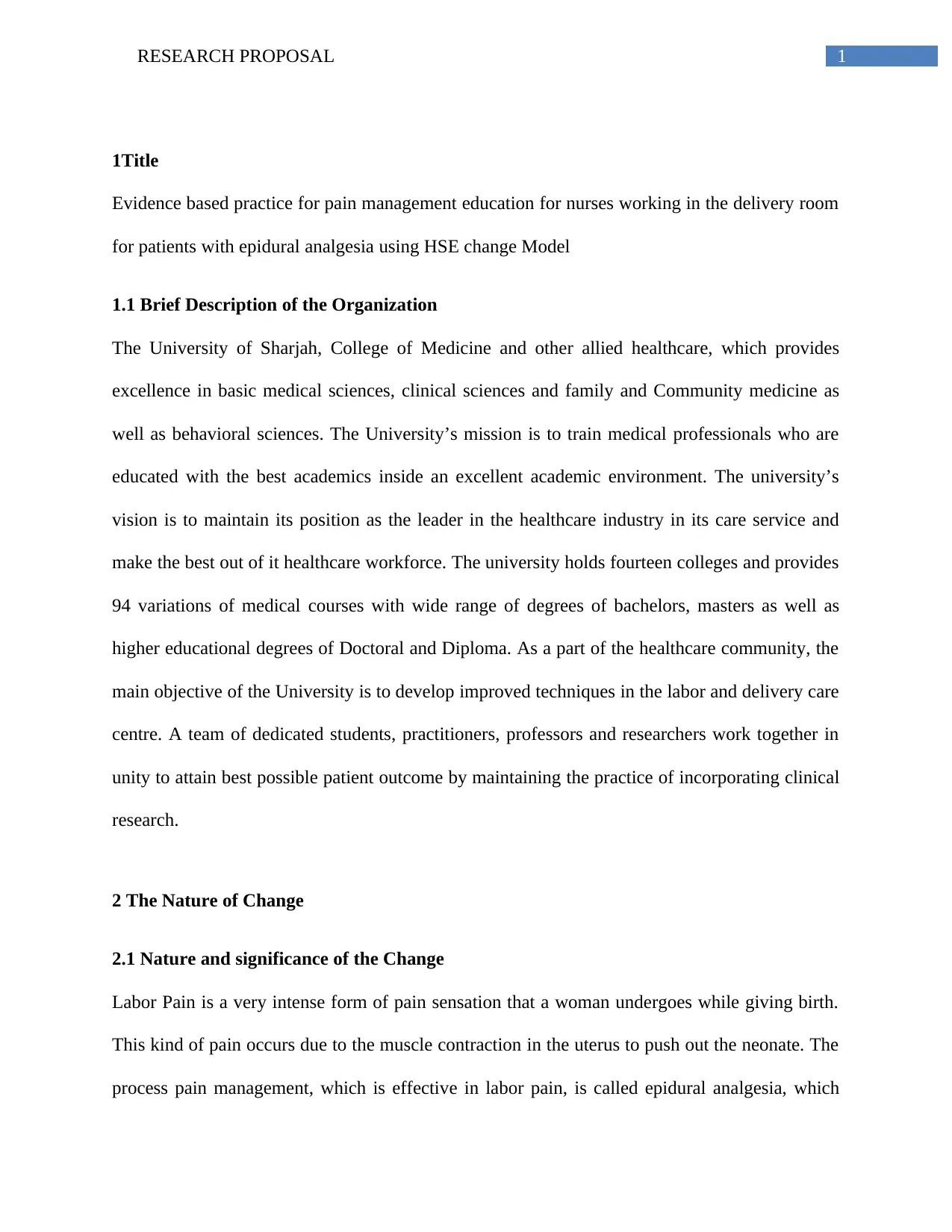
1RESEARCH PROPOSAL
1Title
Evidence based practice for pain management education for nurses working in the delivery room
for patients with epidural analgesia using HSE change Model
1.1 Brief Description of the Organization
The University of Sharjah, College of Medicine and other allied healthcare, which provides
excellence in basic medical sciences, clinical sciences and family and Community medicine as
well as behavioral sciences. The University’s mission is to train medical professionals who are
educated with the best academics inside an excellent academic environment. The university’s
vision is to maintain its position as the leader in the healthcare industry in its care service and
make the best out of it healthcare workforce. The university holds fourteen colleges and provides
94 variations of medical courses with wide range of degrees of bachelors, masters as well as
higher educational degrees of Doctoral and Diploma. As a part of the healthcare community, the
main objective of the University is to develop improved techniques in the labor and delivery care
centre. A team of dedicated students, practitioners, professors and researchers work together in
unity to attain best possible patient outcome by maintaining the practice of incorporating clinical
research.
2 The Nature of Change
2.1 Nature and significance of the Change
Labor Pain is a very intense form of pain sensation that a woman undergoes while giving birth.
This kind of pain occurs due to the muscle contraction in the uterus to push out the neonate. The
process pain management, which is effective in labor pain, is called epidural analgesia, which
1Title
Evidence based practice for pain management education for nurses working in the delivery room
for patients with epidural analgesia using HSE change Model
1.1 Brief Description of the Organization
The University of Sharjah, College of Medicine and other allied healthcare, which provides
excellence in basic medical sciences, clinical sciences and family and Community medicine as
well as behavioral sciences. The University’s mission is to train medical professionals who are
educated with the best academics inside an excellent academic environment. The university’s
vision is to maintain its position as the leader in the healthcare industry in its care service and
make the best out of it healthcare workforce. The university holds fourteen colleges and provides
94 variations of medical courses with wide range of degrees of bachelors, masters as well as
higher educational degrees of Doctoral and Diploma. As a part of the healthcare community, the
main objective of the University is to develop improved techniques in the labor and delivery care
centre. A team of dedicated students, practitioners, professors and researchers work together in
unity to attain best possible patient outcome by maintaining the practice of incorporating clinical
research.
2 The Nature of Change
2.1 Nature and significance of the Change
Labor Pain is a very intense form of pain sensation that a woman undergoes while giving birth.
This kind of pain occurs due to the muscle contraction in the uterus to push out the neonate. The
process pain management, which is effective in labor pain, is called epidural analgesia, which
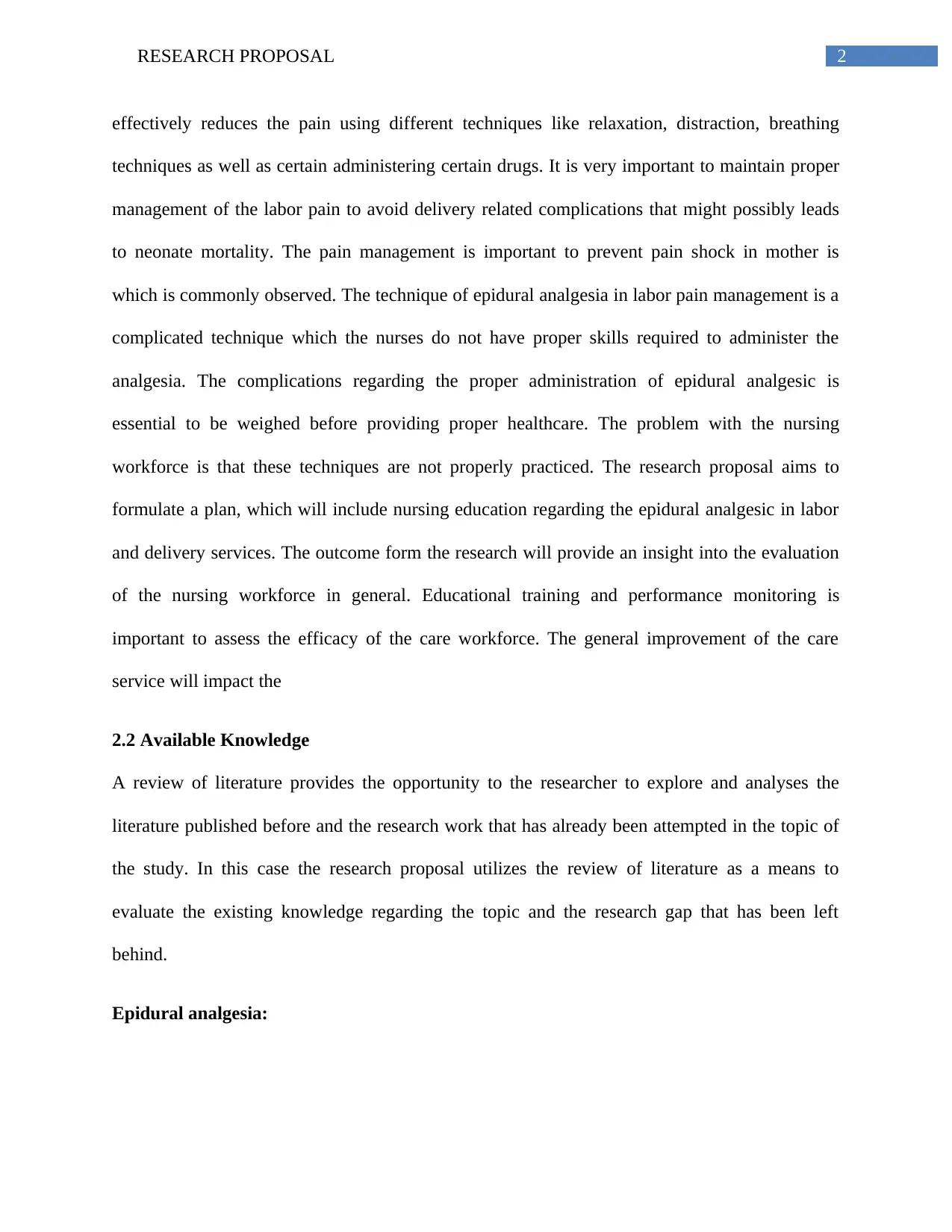
2RESEARCH PROPOSAL
effectively reduces the pain using different techniques like relaxation, distraction, breathing
techniques as well as certain administering certain drugs. It is very important to maintain proper
management of the labor pain to avoid delivery related complications that might possibly leads
to neonate mortality. The pain management is important to prevent pain shock in mother is
which is commonly observed. The technique of epidural analgesia in labor pain management is a
complicated technique which the nurses do not have proper skills required to administer the
analgesia. The complications regarding the proper administration of epidural analgesic is
essential to be weighed before providing proper healthcare. The problem with the nursing
workforce is that these techniques are not properly practiced. The research proposal aims to
formulate a plan, which will include nursing education regarding the epidural analgesic in labor
and delivery services. The outcome form the research will provide an insight into the evaluation
of the nursing workforce in general. Educational training and performance monitoring is
important to assess the efficacy of the care workforce. The general improvement of the care
service will impact the
2.2 Available Knowledge
A review of literature provides the opportunity to the researcher to explore and analyses the
literature published before and the research work that has already been attempted in the topic of
the study. In this case the research proposal utilizes the review of literature as a means to
evaluate the existing knowledge regarding the topic and the research gap that has been left
behind.
Epidural analgesia:
effectively reduces the pain using different techniques like relaxation, distraction, breathing
techniques as well as certain administering certain drugs. It is very important to maintain proper
management of the labor pain to avoid delivery related complications that might possibly leads
to neonate mortality. The pain management is important to prevent pain shock in mother is
which is commonly observed. The technique of epidural analgesia in labor pain management is a
complicated technique which the nurses do not have proper skills required to administer the
analgesia. The complications regarding the proper administration of epidural analgesic is
essential to be weighed before providing proper healthcare. The problem with the nursing
workforce is that these techniques are not properly practiced. The research proposal aims to
formulate a plan, which will include nursing education regarding the epidural analgesic in labor
and delivery services. The outcome form the research will provide an insight into the evaluation
of the nursing workforce in general. Educational training and performance monitoring is
important to assess the efficacy of the care workforce. The general improvement of the care
service will impact the
2.2 Available Knowledge
A review of literature provides the opportunity to the researcher to explore and analyses the
literature published before and the research work that has already been attempted in the topic of
the study. In this case the research proposal utilizes the review of literature as a means to
evaluate the existing knowledge regarding the topic and the research gap that has been left
behind.
Epidural analgesia:
⊘ This is a preview!⊘
Do you want full access?
Subscribe today to unlock all pages.

Trusted by 1+ million students worldwide
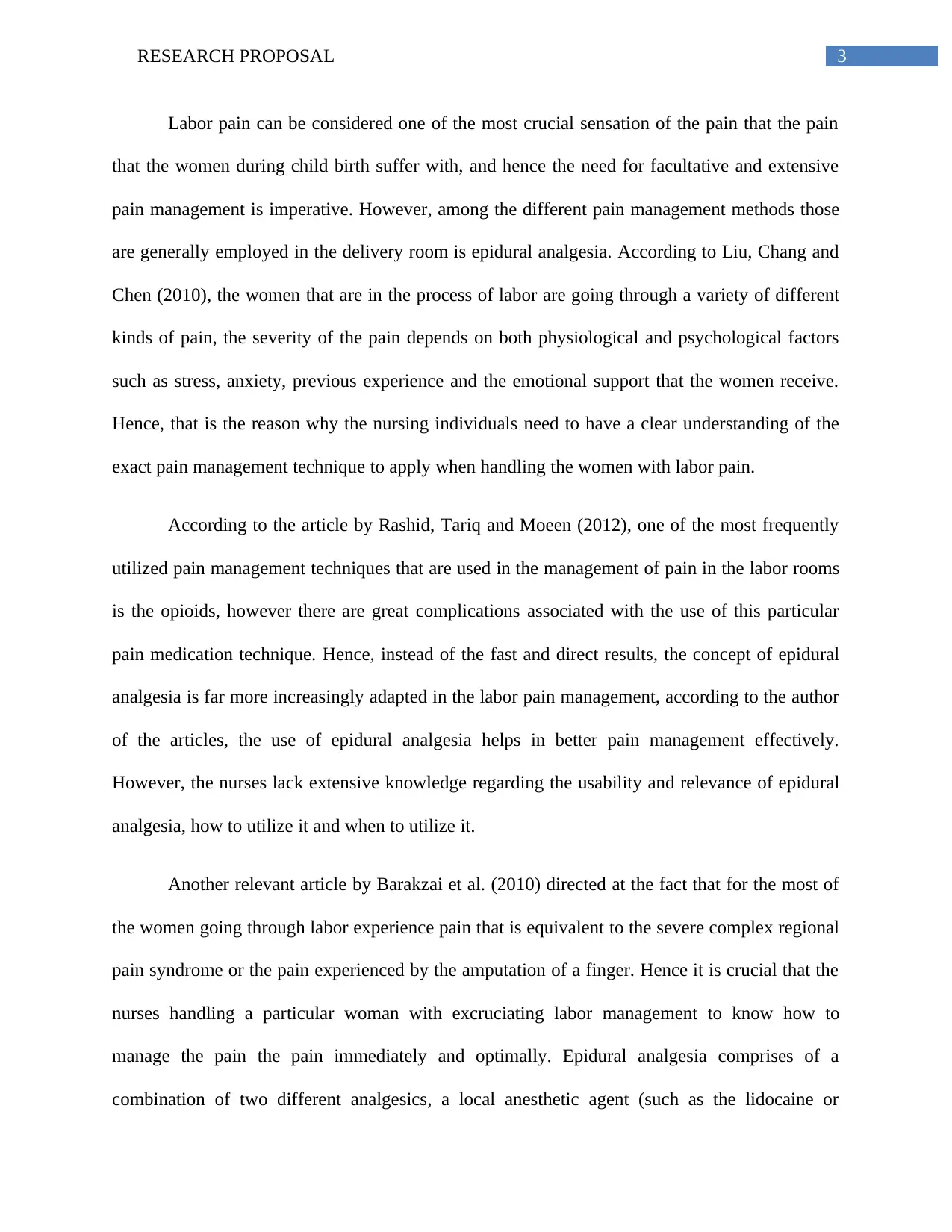
3RESEARCH PROPOSAL
Labor pain can be considered one of the most crucial sensation of the pain that the pain
that the women during child birth suffer with, and hence the need for facultative and extensive
pain management is imperative. However, among the different pain management methods those
are generally employed in the delivery room is epidural analgesia. According to Liu, Chang and
Chen (2010), the women that are in the process of labor are going through a variety of different
kinds of pain, the severity of the pain depends on both physiological and psychological factors
such as stress, anxiety, previous experience and the emotional support that the women receive.
Hence, that is the reason why the nursing individuals need to have a clear understanding of the
exact pain management technique to apply when handling the women with labor pain.
According to the article by Rashid, Tariq and Moeen (2012), one of the most frequently
utilized pain management techniques that are used in the management of pain in the labor rooms
is the opioids, however there are great complications associated with the use of this particular
pain medication technique. Hence, instead of the fast and direct results, the concept of epidural
analgesia is far more increasingly adapted in the labor pain management, according to the author
of the articles, the use of epidural analgesia helps in better pain management effectively.
However, the nurses lack extensive knowledge regarding the usability and relevance of epidural
analgesia, how to utilize it and when to utilize it.
Another relevant article by Barakzai et al. (2010) directed at the fact that for the most of
the women going through labor experience pain that is equivalent to the severe complex regional
pain syndrome or the pain experienced by the amputation of a finger. Hence it is crucial that the
nurses handling a particular woman with excruciating labor management to know how to
manage the pain the pain immediately and optimally. Epidural analgesia comprises of a
combination of two different analgesics, a local anesthetic agent (such as the lidocaine or
Labor pain can be considered one of the most crucial sensation of the pain that the pain
that the women during child birth suffer with, and hence the need for facultative and extensive
pain management is imperative. However, among the different pain management methods those
are generally employed in the delivery room is epidural analgesia. According to Liu, Chang and
Chen (2010), the women that are in the process of labor are going through a variety of different
kinds of pain, the severity of the pain depends on both physiological and psychological factors
such as stress, anxiety, previous experience and the emotional support that the women receive.
Hence, that is the reason why the nursing individuals need to have a clear understanding of the
exact pain management technique to apply when handling the women with labor pain.
According to the article by Rashid, Tariq and Moeen (2012), one of the most frequently
utilized pain management techniques that are used in the management of pain in the labor rooms
is the opioids, however there are great complications associated with the use of this particular
pain medication technique. Hence, instead of the fast and direct results, the concept of epidural
analgesia is far more increasingly adapted in the labor pain management, according to the author
of the articles, the use of epidural analgesia helps in better pain management effectively.
However, the nurses lack extensive knowledge regarding the usability and relevance of epidural
analgesia, how to utilize it and when to utilize it.
Another relevant article by Barakzai et al. (2010) directed at the fact that for the most of
the women going through labor experience pain that is equivalent to the severe complex regional
pain syndrome or the pain experienced by the amputation of a finger. Hence it is crucial that the
nurses handling a particular woman with excruciating labor management to know how to
manage the pain the pain immediately and optimally. Epidural analgesia comprises of a
combination of two different analgesics, a local anesthetic agent (such as the lidocaine or
Paraphrase This Document
Need a fresh take? Get an instant paraphrase of this document with our AI Paraphraser
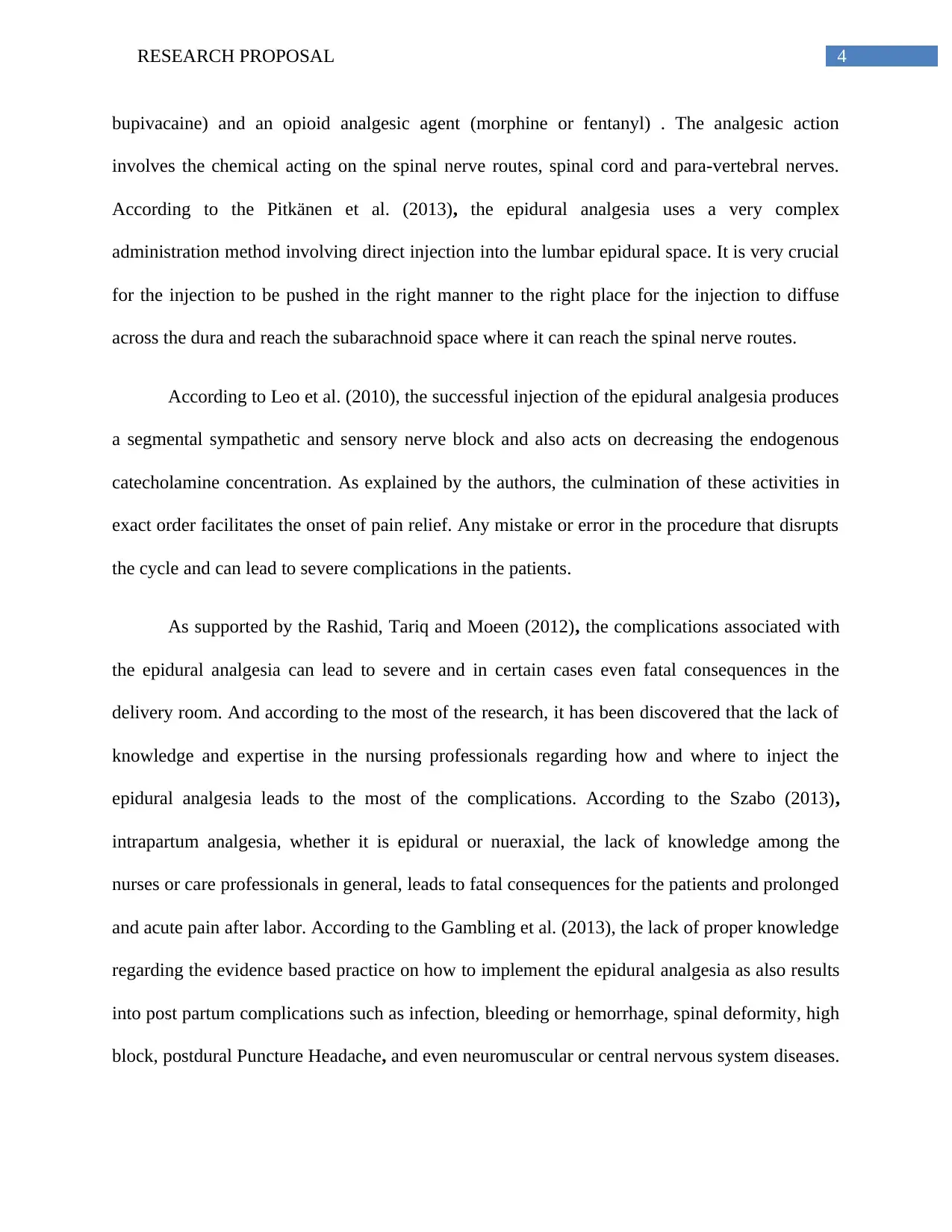
4RESEARCH PROPOSAL
bupivacaine) and an opioid analgesic agent (morphine or fentanyl) . The analgesic action
involves the chemical acting on the spinal nerve routes, spinal cord and para-vertebral nerves.
According to the Pitkänen et al. (2013), the epidural analgesia uses a very complex
administration method involving direct injection into the lumbar epidural space. It is very crucial
for the injection to be pushed in the right manner to the right place for the injection to diffuse
across the dura and reach the subarachnoid space where it can reach the spinal nerve routes.
According to Leo et al. (2010), the successful injection of the epidural analgesia produces
a segmental sympathetic and sensory nerve block and also acts on decreasing the endogenous
catecholamine concentration. As explained by the authors, the culmination of these activities in
exact order facilitates the onset of pain relief. Any mistake or error in the procedure that disrupts
the cycle and can lead to severe complications in the patients.
As supported by the Rashid, Tariq and Moeen (2012), the complications associated with
the epidural analgesia can lead to severe and in certain cases even fatal consequences in the
delivery room. And according to the most of the research, it has been discovered that the lack of
knowledge and expertise in the nursing professionals regarding how and where to inject the
epidural analgesia leads to the most of the complications. According to the Szabo (2013),
intrapartum analgesia, whether it is epidural or nueraxial, the lack of knowledge among the
nurses or care professionals in general, leads to fatal consequences for the patients and prolonged
and acute pain after labor. According to the Gambling et al. (2013), the lack of proper knowledge
regarding the evidence based practice on how to implement the epidural analgesia as also results
into post partum complications such as infection, bleeding or hemorrhage, spinal deformity, high
block, postdural Puncture Headache, and even neuromuscular or central nervous system diseases.
bupivacaine) and an opioid analgesic agent (morphine or fentanyl) . The analgesic action
involves the chemical acting on the spinal nerve routes, spinal cord and para-vertebral nerves.
According to the Pitkänen et al. (2013), the epidural analgesia uses a very complex
administration method involving direct injection into the lumbar epidural space. It is very crucial
for the injection to be pushed in the right manner to the right place for the injection to diffuse
across the dura and reach the subarachnoid space where it can reach the spinal nerve routes.
According to Leo et al. (2010), the successful injection of the epidural analgesia produces
a segmental sympathetic and sensory nerve block and also acts on decreasing the endogenous
catecholamine concentration. As explained by the authors, the culmination of these activities in
exact order facilitates the onset of pain relief. Any mistake or error in the procedure that disrupts
the cycle and can lead to severe complications in the patients.
As supported by the Rashid, Tariq and Moeen (2012), the complications associated with
the epidural analgesia can lead to severe and in certain cases even fatal consequences in the
delivery room. And according to the most of the research, it has been discovered that the lack of
knowledge and expertise in the nursing professionals regarding how and where to inject the
epidural analgesia leads to the most of the complications. According to the Szabo (2013),
intrapartum analgesia, whether it is epidural or nueraxial, the lack of knowledge among the
nurses or care professionals in general, leads to fatal consequences for the patients and prolonged
and acute pain after labor. According to the Gambling et al. (2013), the lack of proper knowledge
regarding the evidence based practice on how to implement the epidural analgesia as also results
into post partum complications such as infection, bleeding or hemorrhage, spinal deformity, high
block, postdural Puncture Headache, and even neuromuscular or central nervous system diseases.
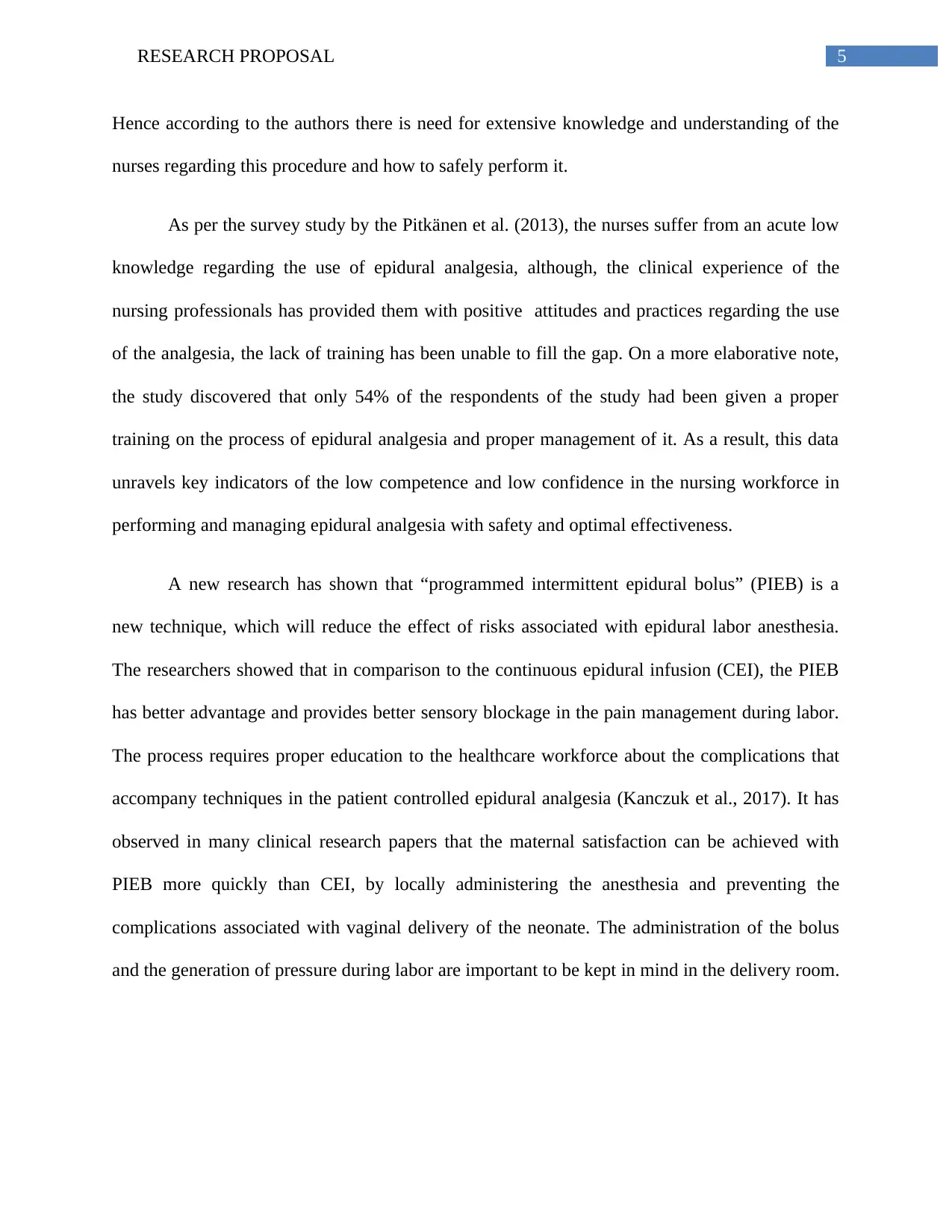
5RESEARCH PROPOSAL
Hence according to the authors there is need for extensive knowledge and understanding of the
nurses regarding this procedure and how to safely perform it.
As per the survey study by the Pitkänen et al. (2013), the nurses suffer from an acute low
knowledge regarding the use of epidural analgesia, although, the clinical experience of the
nursing professionals has provided them with positive attitudes and practices regarding the use
of the analgesia, the lack of training has been unable to fill the gap. On a more elaborative note,
the study discovered that only 54% of the respondents of the study had been given a proper
training on the process of epidural analgesia and proper management of it. As a result, this data
unravels key indicators of the low competence and low confidence in the nursing workforce in
performing and managing epidural analgesia with safety and optimal effectiveness.
A new research has shown that “programmed intermittent epidural bolus” (PIEB) is a
new technique, which will reduce the effect of risks associated with epidural labor anesthesia.
The researchers showed that in comparison to the continuous epidural infusion (CEI), the PIEB
has better advantage and provides better sensory blockage in the pain management during labor.
The process requires proper education to the healthcare workforce about the complications that
accompany techniques in the patient controlled epidural analgesia (Kanczuk et al., 2017). It has
observed in many clinical research papers that the maternal satisfaction can be achieved with
PIEB more quickly than CEI, by locally administering the anesthesia and preventing the
complications associated with vaginal delivery of the neonate. The administration of the bolus
and the generation of pressure during labor are important to be kept in mind in the delivery room.
Hence according to the authors there is need for extensive knowledge and understanding of the
nurses regarding this procedure and how to safely perform it.
As per the survey study by the Pitkänen et al. (2013), the nurses suffer from an acute low
knowledge regarding the use of epidural analgesia, although, the clinical experience of the
nursing professionals has provided them with positive attitudes and practices regarding the use
of the analgesia, the lack of training has been unable to fill the gap. On a more elaborative note,
the study discovered that only 54% of the respondents of the study had been given a proper
training on the process of epidural analgesia and proper management of it. As a result, this data
unravels key indicators of the low competence and low confidence in the nursing workforce in
performing and managing epidural analgesia with safety and optimal effectiveness.
A new research has shown that “programmed intermittent epidural bolus” (PIEB) is a
new technique, which will reduce the effect of risks associated with epidural labor anesthesia.
The researchers showed that in comparison to the continuous epidural infusion (CEI), the PIEB
has better advantage and provides better sensory blockage in the pain management during labor.
The process requires proper education to the healthcare workforce about the complications that
accompany techniques in the patient controlled epidural analgesia (Kanczuk et al., 2017). It has
observed in many clinical research papers that the maternal satisfaction can be achieved with
PIEB more quickly than CEI, by locally administering the anesthesia and preventing the
complications associated with vaginal delivery of the neonate. The administration of the bolus
and the generation of pressure during labor are important to be kept in mind in the delivery room.
⊘ This is a preview!⊘
Do you want full access?
Subscribe today to unlock all pages.

Trusted by 1+ million students worldwide
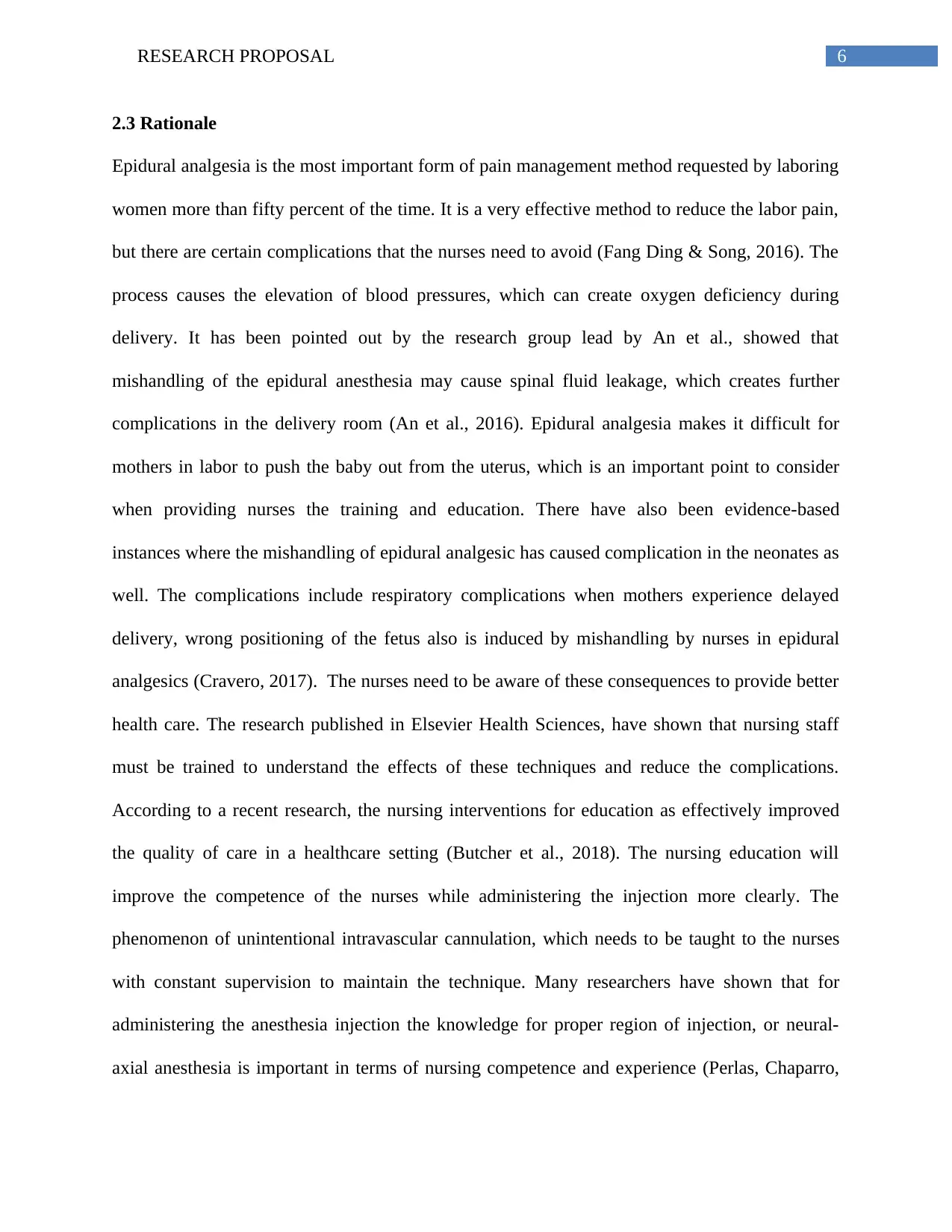
6RESEARCH PROPOSAL
2.3 Rationale
Epidural analgesia is the most important form of pain management method requested by laboring
women more than fifty percent of the time. It is a very effective method to reduce the labor pain,
but there are certain complications that the nurses need to avoid (Fang Ding & Song, 2016). The
process causes the elevation of blood pressures, which can create oxygen deficiency during
delivery. It has been pointed out by the research group lead by An et al., showed that
mishandling of the epidural anesthesia may cause spinal fluid leakage, which creates further
complications in the delivery room (An et al., 2016). Epidural analgesia makes it difficult for
mothers in labor to push the baby out from the uterus, which is an important point to consider
when providing nurses the training and education. There have also been evidence-based
instances where the mishandling of epidural analgesic has caused complication in the neonates as
well. The complications include respiratory complications when mothers experience delayed
delivery, wrong positioning of the fetus also is induced by mishandling by nurses in epidural
analgesics (Cravero, 2017). The nurses need to be aware of these consequences to provide better
health care. The research published in Elsevier Health Sciences, have shown that nursing staff
must be trained to understand the effects of these techniques and reduce the complications.
According to a recent research, the nursing interventions for education as effectively improved
the quality of care in a healthcare setting (Butcher et al., 2018). The nursing education will
improve the competence of the nurses while administering the injection more clearly. The
phenomenon of unintentional intravascular cannulation, which needs to be taught to the nurses
with constant supervision to maintain the technique. Many researchers have shown that for
administering the anesthesia injection the knowledge for proper region of injection, or neural-
axial anesthesia is important in terms of nursing competence and experience (Perlas, Chaparro,
2.3 Rationale
Epidural analgesia is the most important form of pain management method requested by laboring
women more than fifty percent of the time. It is a very effective method to reduce the labor pain,
but there are certain complications that the nurses need to avoid (Fang Ding & Song, 2016). The
process causes the elevation of blood pressures, which can create oxygen deficiency during
delivery. It has been pointed out by the research group lead by An et al., showed that
mishandling of the epidural anesthesia may cause spinal fluid leakage, which creates further
complications in the delivery room (An et al., 2016). Epidural analgesia makes it difficult for
mothers in labor to push the baby out from the uterus, which is an important point to consider
when providing nurses the training and education. There have also been evidence-based
instances where the mishandling of epidural analgesic has caused complication in the neonates as
well. The complications include respiratory complications when mothers experience delayed
delivery, wrong positioning of the fetus also is induced by mishandling by nurses in epidural
analgesics (Cravero, 2017). The nurses need to be aware of these consequences to provide better
health care. The research published in Elsevier Health Sciences, have shown that nursing staff
must be trained to understand the effects of these techniques and reduce the complications.
According to a recent research, the nursing interventions for education as effectively improved
the quality of care in a healthcare setting (Butcher et al., 2018). The nursing education will
improve the competence of the nurses while administering the injection more clearly. The
phenomenon of unintentional intravascular cannulation, which needs to be taught to the nurses
with constant supervision to maintain the technique. Many researchers have shown that for
administering the anesthesia injection the knowledge for proper region of injection, or neural-
axial anesthesia is important in terms of nursing competence and experience (Perlas, Chaparro,
Paraphrase This Document
Need a fresh take? Get an instant paraphrase of this document with our AI Paraphraser
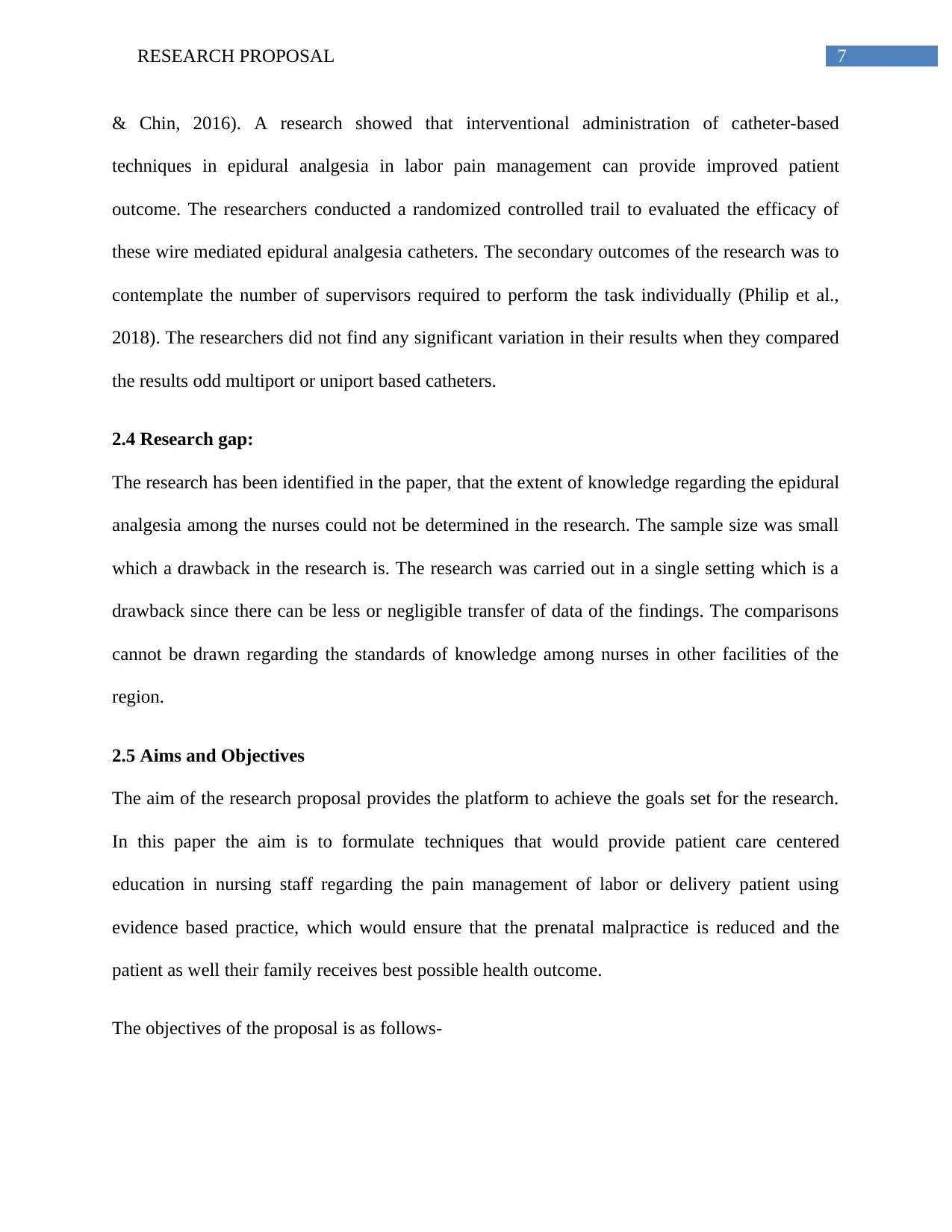
7RESEARCH PROPOSAL
& Chin, 2016). A research showed that interventional administration of catheter-based
techniques in epidural analgesia in labor pain management can provide improved patient
outcome. The researchers conducted a randomized controlled trail to evaluated the efficacy of
these wire mediated epidural analgesia catheters. The secondary outcomes of the research was to
contemplate the number of supervisors required to perform the task individually (Philip et al.,
2018). The researchers did not find any significant variation in their results when they compared
the results odd multiport or uniport based catheters.
2.4 Research gap:
The research has been identified in the paper, that the extent of knowledge regarding the epidural
analgesia among the nurses could not be determined in the research. The sample size was small
which a drawback in the research is. The research was carried out in a single setting which is a
drawback since there can be less or negligible transfer of data of the findings. The comparisons
cannot be drawn regarding the standards of knowledge among nurses in other facilities of the
region.
2.5 Aims and Objectives
The aim of the research proposal provides the platform to achieve the goals set for the research.
In this paper the aim is to formulate techniques that would provide patient care centered
education in nursing staff regarding the pain management of labor or delivery patient using
evidence based practice, which would ensure that the prenatal malpractice is reduced and the
patient as well their family receives best possible health outcome.
The objectives of the proposal is as follows-
& Chin, 2016). A research showed that interventional administration of catheter-based
techniques in epidural analgesia in labor pain management can provide improved patient
outcome. The researchers conducted a randomized controlled trail to evaluated the efficacy of
these wire mediated epidural analgesia catheters. The secondary outcomes of the research was to
contemplate the number of supervisors required to perform the task individually (Philip et al.,
2018). The researchers did not find any significant variation in their results when they compared
the results odd multiport or uniport based catheters.
2.4 Research gap:
The research has been identified in the paper, that the extent of knowledge regarding the epidural
analgesia among the nurses could not be determined in the research. The sample size was small
which a drawback in the research is. The research was carried out in a single setting which is a
drawback since there can be less or negligible transfer of data of the findings. The comparisons
cannot be drawn regarding the standards of knowledge among nurses in other facilities of the
region.
2.5 Aims and Objectives
The aim of the research proposal provides the platform to achieve the goals set for the research.
In this paper the aim is to formulate techniques that would provide patient care centered
education in nursing staff regarding the pain management of labor or delivery patient using
evidence based practice, which would ensure that the prenatal malpractice is reduced and the
patient as well their family receives best possible health outcome.
The objectives of the proposal is as follows-
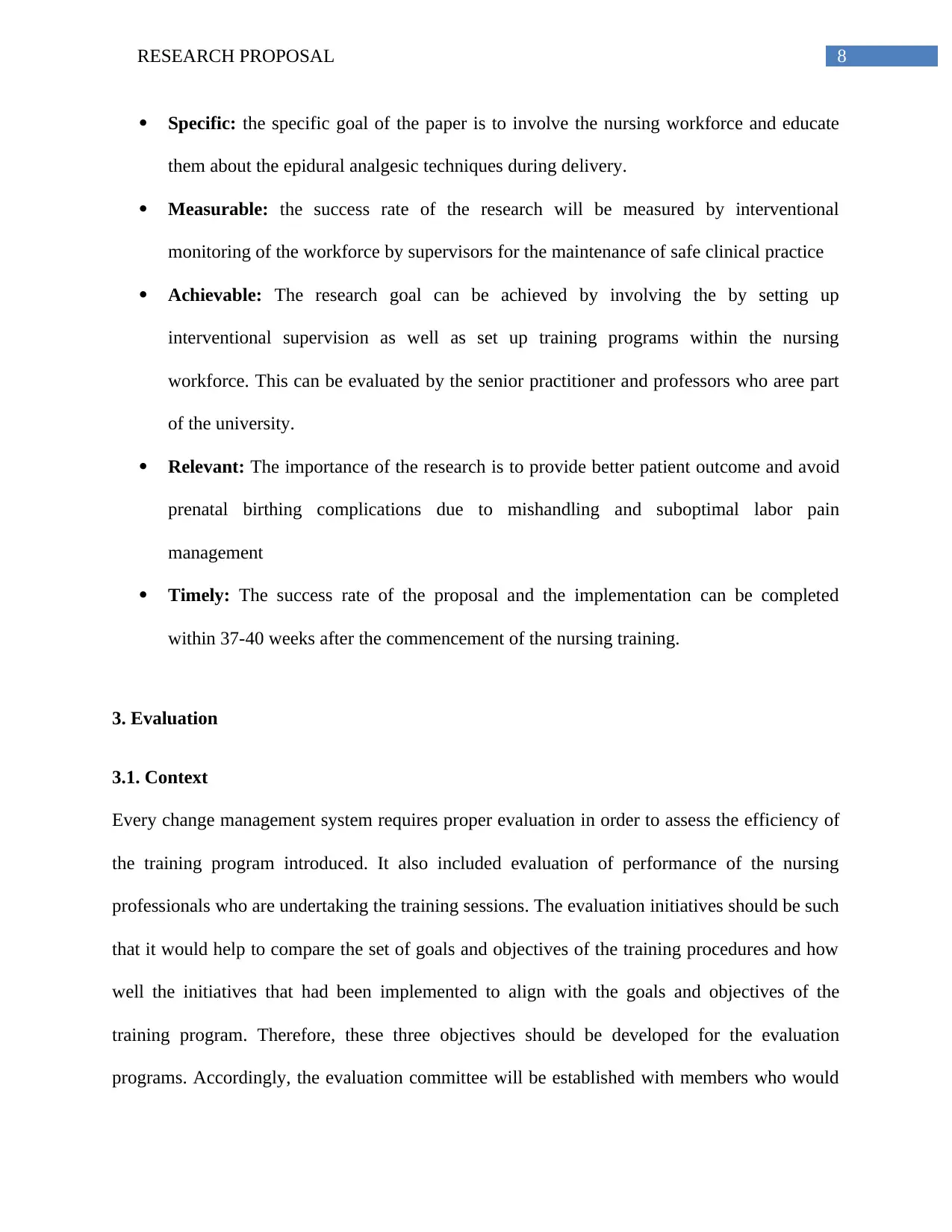
8RESEARCH PROPOSAL
Specific: the specific goal of the paper is to involve the nursing workforce and educate
them about the epidural analgesic techniques during delivery.
Measurable: the success rate of the research will be measured by interventional
monitoring of the workforce by supervisors for the maintenance of safe clinical practice
Achievable: The research goal can be achieved by involving the by setting up
interventional supervision as well as set up training programs within the nursing
workforce. This can be evaluated by the senior practitioner and professors who aree part
of the university.
Relevant: The importance of the research is to provide better patient outcome and avoid
prenatal birthing complications due to mishandling and suboptimal labor pain
management
Timely: The success rate of the proposal and the implementation can be completed
within 37-40 weeks after the commencement of the nursing training.
3. Evaluation
3.1. Context
Every change management system requires proper evaluation in order to assess the efficiency of
the training program introduced. It also included evaluation of performance of the nursing
professionals who are undertaking the training sessions. The evaluation initiatives should be such
that it would help to compare the set of goals and objectives of the training procedures and how
well the initiatives that had been implemented to align with the goals and objectives of the
training program. Therefore, these three objectives should be developed for the evaluation
programs. Accordingly, the evaluation committee will be established with members who would
Specific: the specific goal of the paper is to involve the nursing workforce and educate
them about the epidural analgesic techniques during delivery.
Measurable: the success rate of the research will be measured by interventional
monitoring of the workforce by supervisors for the maintenance of safe clinical practice
Achievable: The research goal can be achieved by involving the by setting up
interventional supervision as well as set up training programs within the nursing
workforce. This can be evaluated by the senior practitioner and professors who aree part
of the university.
Relevant: The importance of the research is to provide better patient outcome and avoid
prenatal birthing complications due to mishandling and suboptimal labor pain
management
Timely: The success rate of the proposal and the implementation can be completed
within 37-40 weeks after the commencement of the nursing training.
3. Evaluation
3.1. Context
Every change management system requires proper evaluation in order to assess the efficiency of
the training program introduced. It also included evaluation of performance of the nursing
professionals who are undertaking the training sessions. The evaluation initiatives should be such
that it would help to compare the set of goals and objectives of the training procedures and how
well the initiatives that had been implemented to align with the goals and objectives of the
training program. Therefore, these three objectives should be developed for the evaluation
programs. Accordingly, the evaluation committee will be established with members who would
⊘ This is a preview!⊘
Do you want full access?
Subscribe today to unlock all pages.

Trusted by 1+ million students worldwide
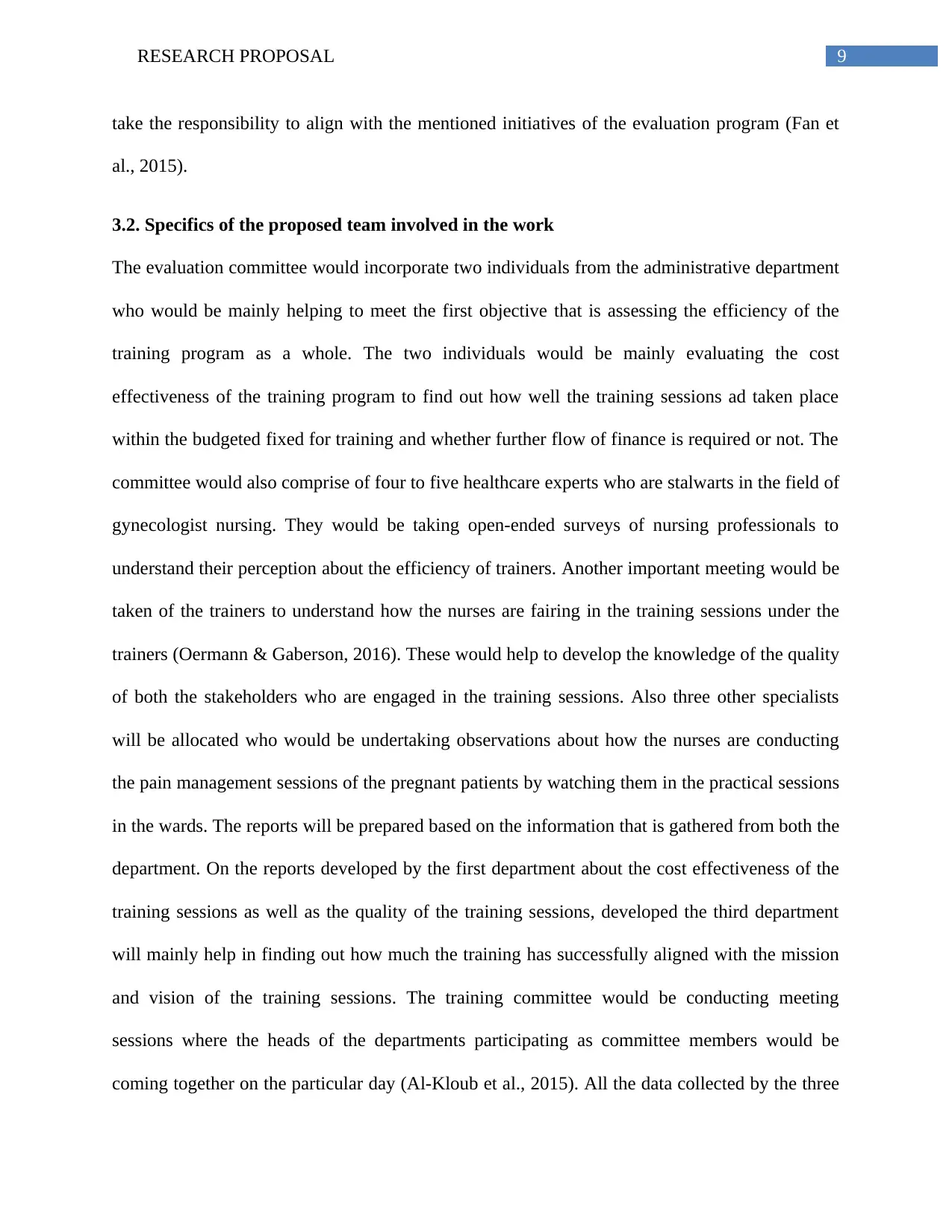
9RESEARCH PROPOSAL
take the responsibility to align with the mentioned initiatives of the evaluation program (Fan et
al., 2015).
3.2. Specifics of the proposed team involved in the work
The evaluation committee would incorporate two individuals from the administrative department
who would be mainly helping to meet the first objective that is assessing the efficiency of the
training program as a whole. The two individuals would be mainly evaluating the cost
effectiveness of the training program to find out how well the training sessions ad taken place
within the budgeted fixed for training and whether further flow of finance is required or not. The
committee would also comprise of four to five healthcare experts who are stalwarts in the field of
gynecologist nursing. They would be taking open-ended surveys of nursing professionals to
understand their perception about the efficiency of trainers. Another important meeting would be
taken of the trainers to understand how the nurses are fairing in the training sessions under the
trainers (Oermann & Gaberson, 2016). These would help to develop the knowledge of the quality
of both the stakeholders who are engaged in the training sessions. Also three other specialists
will be allocated who would be undertaking observations about how the nurses are conducting
the pain management sessions of the pregnant patients by watching them in the practical sessions
in the wards. The reports will be prepared based on the information that is gathered from both the
department. On the reports developed by the first department about the cost effectiveness of the
training sessions as well as the quality of the training sessions, developed the third department
will mainly help in finding out how much the training has successfully aligned with the mission
and vision of the training sessions. The training committee would be conducting meeting
sessions where the heads of the departments participating as committee members would be
coming together on the particular day (Al-Kloub et al., 2015). All the data collected by the three
take the responsibility to align with the mentioned initiatives of the evaluation program (Fan et
al., 2015).
3.2. Specifics of the proposed team involved in the work
The evaluation committee would incorporate two individuals from the administrative department
who would be mainly helping to meet the first objective that is assessing the efficiency of the
training program as a whole. The two individuals would be mainly evaluating the cost
effectiveness of the training program to find out how well the training sessions ad taken place
within the budgeted fixed for training and whether further flow of finance is required or not. The
committee would also comprise of four to five healthcare experts who are stalwarts in the field of
gynecologist nursing. They would be taking open-ended surveys of nursing professionals to
understand their perception about the efficiency of trainers. Another important meeting would be
taken of the trainers to understand how the nurses are fairing in the training sessions under the
trainers (Oermann & Gaberson, 2016). These would help to develop the knowledge of the quality
of both the stakeholders who are engaged in the training sessions. Also three other specialists
will be allocated who would be undertaking observations about how the nurses are conducting
the pain management sessions of the pregnant patients by watching them in the practical sessions
in the wards. The reports will be prepared based on the information that is gathered from both the
department. On the reports developed by the first department about the cost effectiveness of the
training sessions as well as the quality of the training sessions, developed the third department
will mainly help in finding out how much the training has successfully aligned with the mission
and vision of the training sessions. The training committee would be conducting meeting
sessions where the heads of the departments participating as committee members would be
coming together on the particular day (Al-Kloub et al., 2015). All the data collected by the three
Paraphrase This Document
Need a fresh take? Get an instant paraphrase of this document with our AI Paraphraser
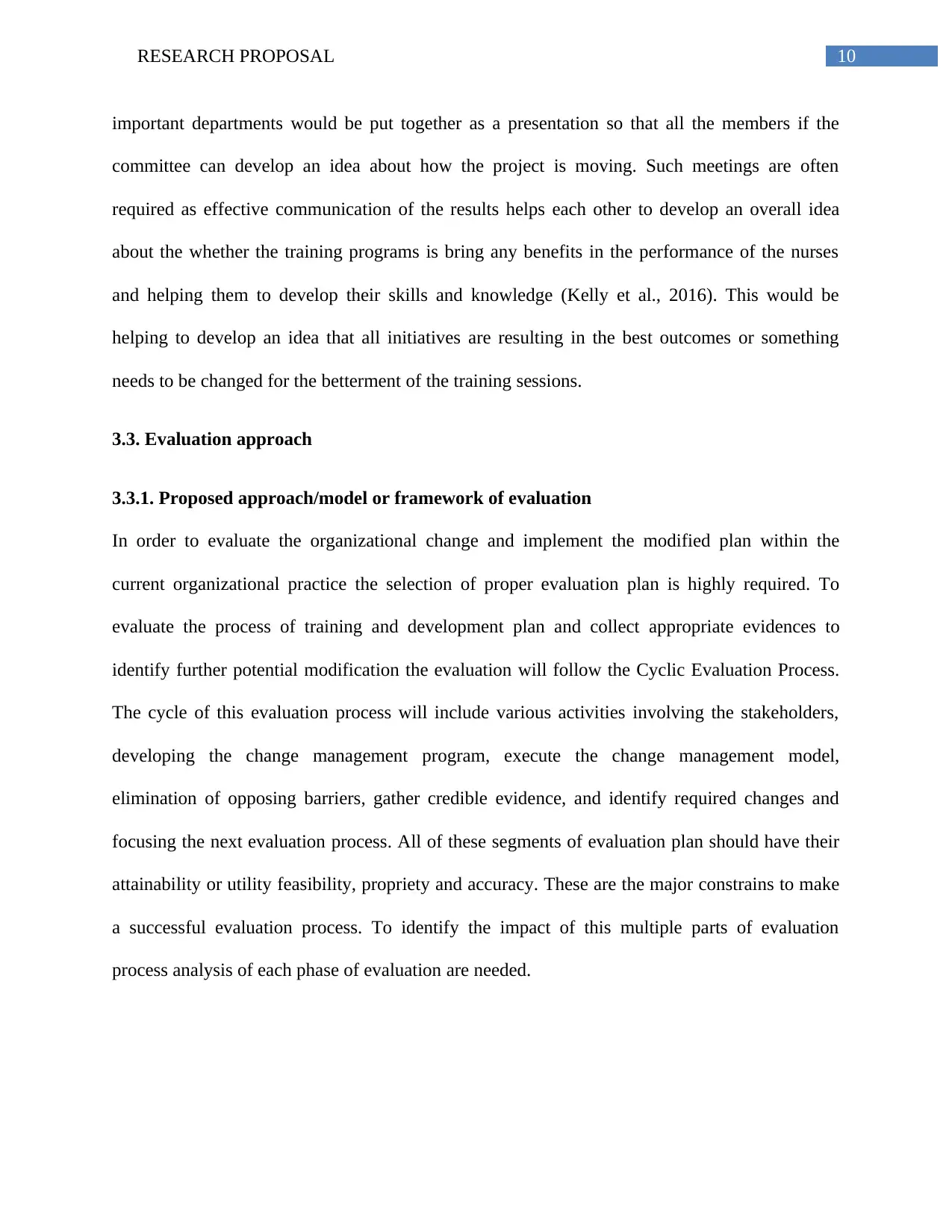
10RESEARCH PROPOSAL
important departments would be put together as a presentation so that all the members if the
committee can develop an idea about how the project is moving. Such meetings are often
required as effective communication of the results helps each other to develop an overall idea
about the whether the training programs is bring any benefits in the performance of the nurses
and helping them to develop their skills and knowledge (Kelly et al., 2016). This would be
helping to develop an idea that all initiatives are resulting in the best outcomes or something
needs to be changed for the betterment of the training sessions.
3.3. Evaluation approach
3.3.1. Proposed approach/model or framework of evaluation
In order to evaluate the organizational change and implement the modified plan within the
current organizational practice the selection of proper evaluation plan is highly required. To
evaluate the process of training and development plan and collect appropriate evidences to
identify further potential modification the evaluation will follow the Cyclic Evaluation Process.
The cycle of this evaluation process will include various activities involving the stakeholders,
developing the change management program, execute the change management model,
elimination of opposing barriers, gather credible evidence, and identify required changes and
focusing the next evaluation process. All of these segments of evaluation plan should have their
attainability or utility feasibility, propriety and accuracy. These are the major constrains to make
a successful evaluation process. To identify the impact of this multiple parts of evaluation
process analysis of each phase of evaluation are needed.
important departments would be put together as a presentation so that all the members if the
committee can develop an idea about how the project is moving. Such meetings are often
required as effective communication of the results helps each other to develop an overall idea
about the whether the training programs is bring any benefits in the performance of the nurses
and helping them to develop their skills and knowledge (Kelly et al., 2016). This would be
helping to develop an idea that all initiatives are resulting in the best outcomes or something
needs to be changed for the betterment of the training sessions.
3.3. Evaluation approach
3.3.1. Proposed approach/model or framework of evaluation
In order to evaluate the organizational change and implement the modified plan within the
current organizational practice the selection of proper evaluation plan is highly required. To
evaluate the process of training and development plan and collect appropriate evidences to
identify further potential modification the evaluation will follow the Cyclic Evaluation Process.
The cycle of this evaluation process will include various activities involving the stakeholders,
developing the change management program, execute the change management model,
elimination of opposing barriers, gather credible evidence, and identify required changes and
focusing the next evaluation process. All of these segments of evaluation plan should have their
attainability or utility feasibility, propriety and accuracy. These are the major constrains to make
a successful evaluation process. To identify the impact of this multiple parts of evaluation
process analysis of each phase of evaluation are needed.
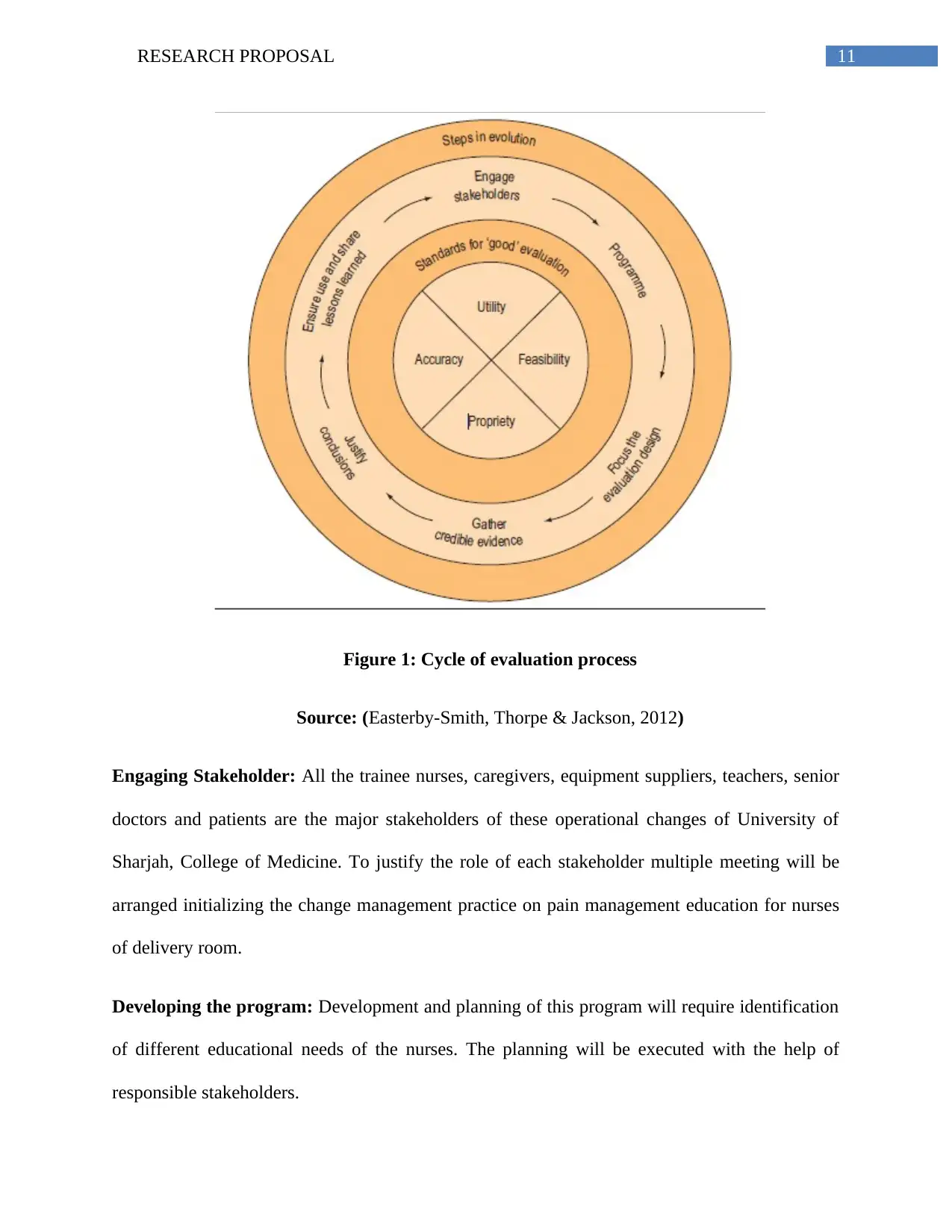
11RESEARCH PROPOSAL
Figure 1: Cycle of evaluation process
Source: (Easterby-Smith, Thorpe & Jackson, 2012)
Engaging Stakeholder: All the trainee nurses, caregivers, equipment suppliers, teachers, senior
doctors and patients are the major stakeholders of these operational changes of University of
Sharjah, College of Medicine. To justify the role of each stakeholder multiple meeting will be
arranged initializing the change management practice on pain management education for nurses
of delivery room.
Developing the program: Development and planning of this program will require identification
of different educational needs of the nurses. The planning will be executed with the help of
responsible stakeholders.
Figure 1: Cycle of evaluation process
Source: (Easterby-Smith, Thorpe & Jackson, 2012)
Engaging Stakeholder: All the trainee nurses, caregivers, equipment suppliers, teachers, senior
doctors and patients are the major stakeholders of these operational changes of University of
Sharjah, College of Medicine. To justify the role of each stakeholder multiple meeting will be
arranged initializing the change management practice on pain management education for nurses
of delivery room.
Developing the program: Development and planning of this program will require identification
of different educational needs of the nurses. The planning will be executed with the help of
responsible stakeholders.
⊘ This is a preview!⊘
Do you want full access?
Subscribe today to unlock all pages.

Trusted by 1+ million students worldwide
1 out of 26
Related Documents
Your All-in-One AI-Powered Toolkit for Academic Success.
+13062052269
info@desklib.com
Available 24*7 on WhatsApp / Email
![[object Object]](/_next/static/media/star-bottom.7253800d.svg)
Unlock your academic potential
Copyright © 2020–2025 A2Z Services. All Rights Reserved. Developed and managed by ZUCOL.





